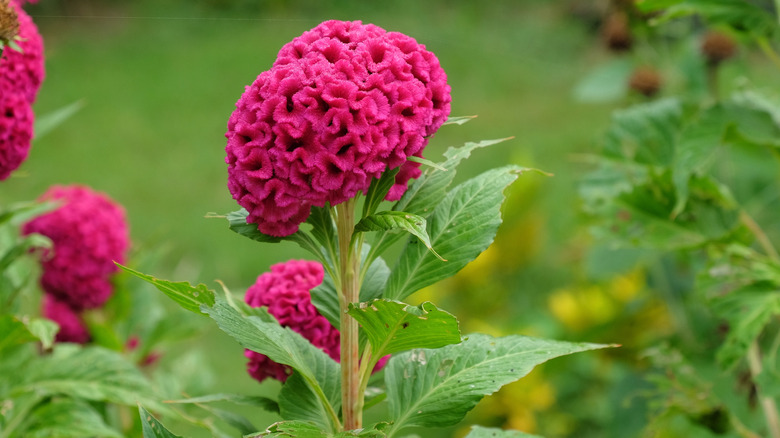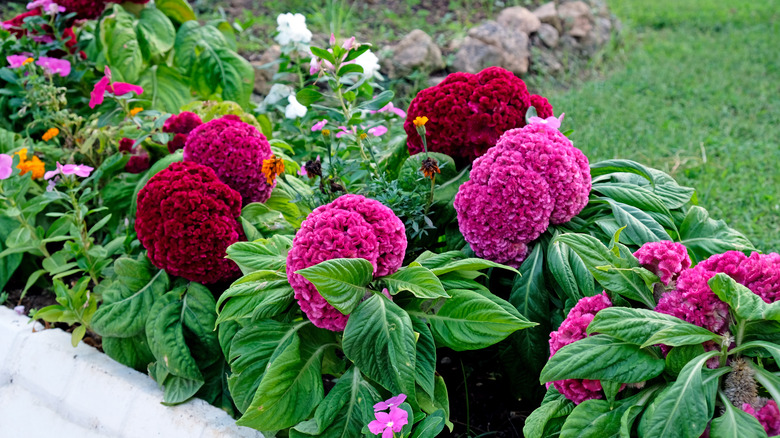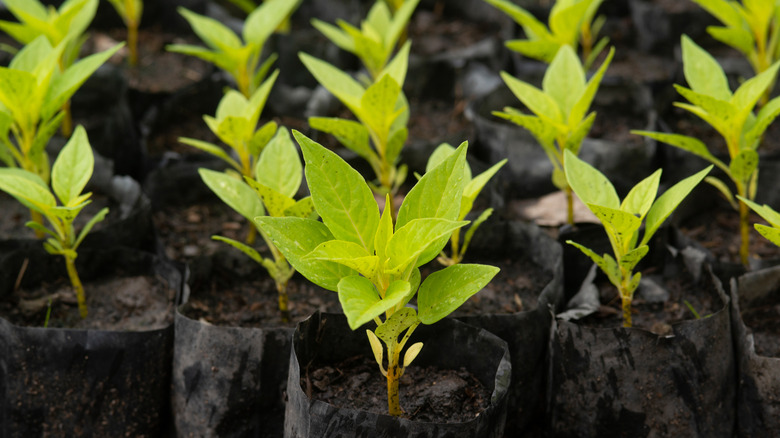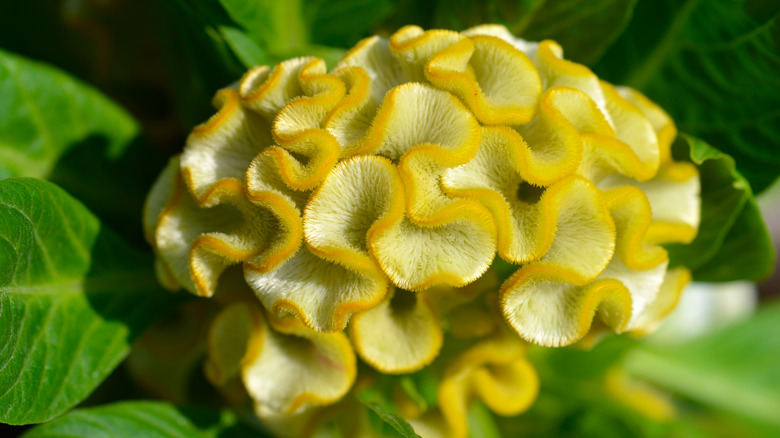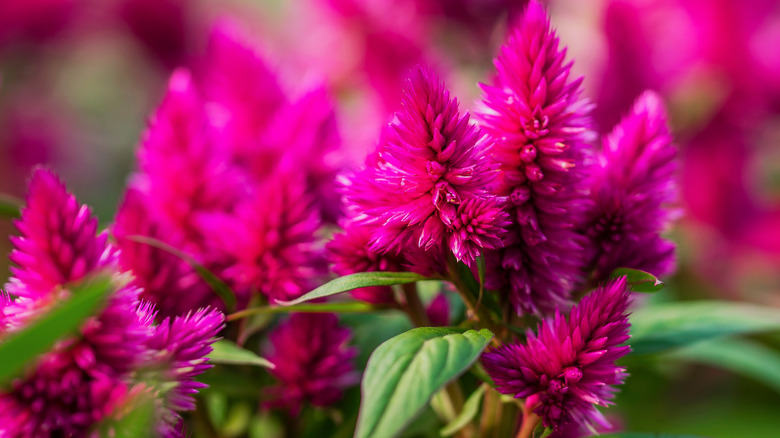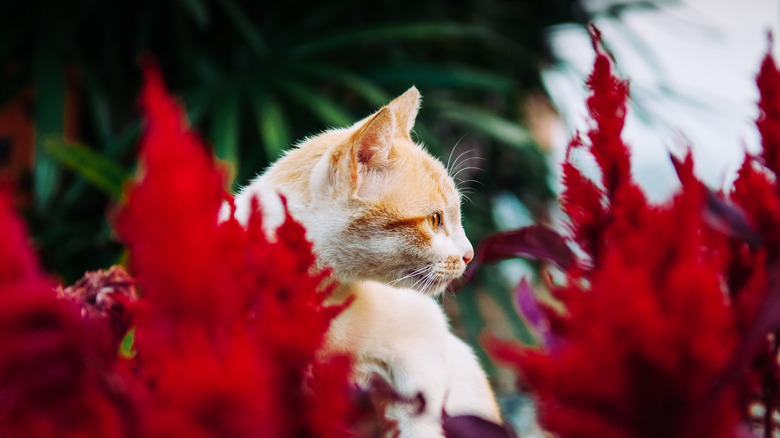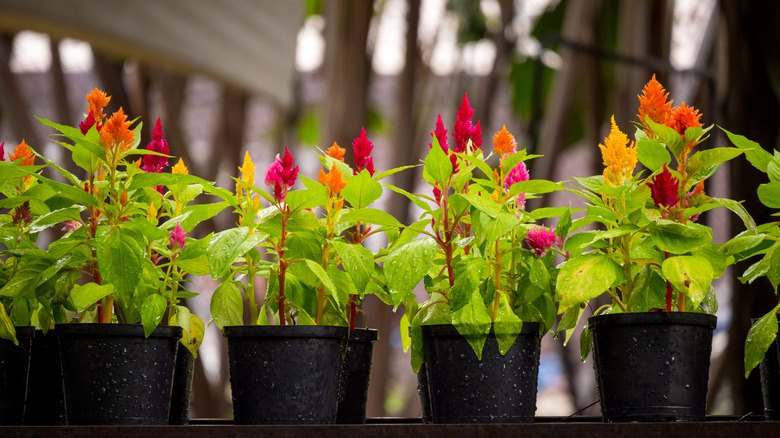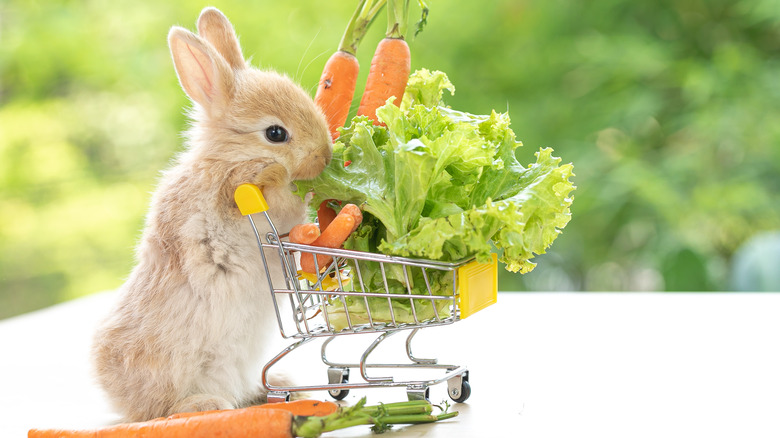How To Grow And Care For Celosia Cockscomb Flowers
What comes up when you type "flower that looks like a brain" into your internet search engine? Celosia cristata cockscomb, of course! These bright and funky blooms are an absolute delight in the garden and their twisting shapes are bound to get your neighbors talking. The genus name of celosia is derived from keleos — the Greek word for burning due to their blazing colors — while cristata translates to crested and refers to their shape, according to Garden Beast. Botanically speaking, celosias belong to the Amaranthaceae family along with edible herbaceous grains like amaranth and quinoa. In fact, in many cultures, celosias themselves are considered edible ornamentals.
Generally considered annuals, unless you live in USDA Zone 10 or above where they won't have to deal with winter, celosias are commonly found in the wild in Asia where they are more akin to weeds, specifically in China.
Clearly, these unique flowers will add a ton of spunk to your garden, but they can also be kept indoors as container plants and make splendid decorations. A great tip from Garden Gate Magazine is to cut bundles of long-stemmed celosias in midsummer and hang them upside down to dry. For best results, make sure the area is well-ventilated, cool, and dry. After four weeks or so, they'll be ready for use as permanent wall ornaments or mixed into centerpiece bouquets. Red, orange, and yellow varieties cut at peak bloom will paint the perfect splash of autumn hues across the Thanksgiving table come November.
How to use celosia flowers in a garden
Celosias can take the heat of these hotter and hotter summers without batting an eyelash. The Texas Cooperative Extension through Texas A&M University says full sun in the garden will make up for any nutrient deficiencies in your soil. That's good news regarding placement if you've got some less than stellar areas in your yard that you'd like to spruce up, and you'll have plumed, crested, and tall spiky variations to choose from. Give them enough sun and water, and all varieties will figure out how to thrive in almost any soil type.
Wherever you decide to plant your celosias, you'll want to make sure they are seen! Cockscomb flowers are show stoppers that can grow over 3 feet high with colossal individual blooms as wide as 10 inches across. They come in a full array of yellows, oranges, reds, and neon pinks that can mix and match with whatever you've got out there. Another possibility is to surround them with evergreen bushes or grasses in order to make the blooms stand out even more. Planted next to shorter plants, cockscombs will add a taller layer and a textured effect. Texas Cooperative Extension adds that celosias look fantastic as part of a triad of annuals in a container. Plant a crested cockscomb in a large pot next to a plumed Celosia plumosa and all you'll need to finish off the look is something soft to wistfully cascade over the sides.
How to grow celosia flowers
It is generally agreed among horticulturists and home gardeners alike that celosias are one of the easier plants to grow from seed. Three Acre Farm expands on that notion with a simple guide for sowing your seeds. Begin your propagation project in the springtime after the final frost. Once you've got your seed trays set up with high-quality seed-starting mix, head to the kitchen and grab some toothpicks. Celosia seeds are so small it will be near impossible to separate them with your bare fingers and you only need to place a single seed into each tray cell. Per Garden Gate Magazine, they do not need to be planted deeply. It's actually better to keep them on the surface so they can soak up the most amount of sunlight.
In order to germinate and sprout, planted seeds need a bright, warm, and moist environment. This holds especially true for any warm-weather plant. So early on into the game, seedlings need every advantage to get them through their most delicate stage. One downfall with celosia seedlings is that if they are left somewhere cool, they are prone to damping off. This is a fungal infection that causes root rot. Heating pads and humidifiers may be the way to go depending on where you're trying to grow them. Covering seedling tray cells with a shallow layer of vermiculite has also been shown to help reduce the possibility of infection.
How to care for celosia flowers
Once they're growing strong, your seedlings will be ready to transplant into the garden. And once they're in their happy garden spot, you're basically good to go. Other than being very thirsty plants that require a lot of water to grow the most impressive flowers, cockscombs don't really need much else from us. Plantura Magazine states that a little bit of fertilizer will go a long way. It's quite possible to feed them too much, which will affect their bloom color. Once a month during the growing season will be more than sufficient.
Texas Cooperative Extension advises that taller celosias may require staking to remain steady if they become top-heavy from their gigantic flowers, especially if you live in a windy area. You can either start propping them up preventatively early in the season as they grow, or you can wait to see if they flop over later. Staking can be done by gently tying the stem to a bamboo support with twine. Tomato cages will be more visible but they'll work just as well. If you've planted your cockscombs along a walking path, you might want to try linking thick wire to create a long, ankle-height fence.
Celosia flower varieties
Cockscomb, wheat, and plumed are the three basic varieties of celosia flowers, as defined by University of Minnesota Extension. Cockscomb produces the brain-shaped blooms sometimes also compared to coral. Wheat celosias come in a smaller range of colors and look quite a bit like — you guessed it — stalks of wheat. Finally, plumed varieties grow closer to the ground, topping out at about 2 feet, and their very bright flowers are triangular shaped and feathery. Within those classifications, there are many cultivars to choose from. Let's take a closer look at a few.
- Celosia argentea 'Intenz Classic' (pictured above) nearly shouts its existence to the world with its stunning fuchsia hue.
- Celosia argentea plumosa 'Fresh Look Gold' has long-living yellow blooms in the plumed structure.
- Celosia argentea var. spicata 'Asian Garden' is one of the spike or wheat forms of the plant that mixes pale pinks with darker tones.
- Celosia cristata 'Nana Jessica' is a yellow dwarf variety that will remain small at 6 inches tall.
- Celosia argentea var. cristata 'Kurume Corona' simply stuns with coral-like twisting flower heads that blend from yellow to pink to orange and back again.
Are celosia flowers toxic?
Far from poisonous, as confirmed by the ASPCA, pet-friendly celosia flowers are commonly considered to be edible ornamentals. Worldwide, the leaves of Celosia spicata (wheat celosia) and Celosia argentea are among the most common leafy greens you've probably never heard of. As such, they are eaten constantly in tropical areas of Southeast Asia and Africa. Food & Wine goes so far as to say it's not just that you can eat celosia leaves, but you should do it. They are rich in iron and, according to chef Yusuf Bin-Rella of West Africa, they taste much better than spinach.
And yet, celosia plants are not only uniquely gorgeous and full of flavor, but they also have a long list of medicinal uses to boot. In a study published by BMC Complementary Medicine and Therapies, Celosia cristata has been shown to treat many ailments. It has been used in traditional folk medicine to alleviate headaches, common issues experienced during menstruation, and even carpal tunnel syndrome. Seeds from this plant can help treat mouth sores. Furthermore, the leaves can be wrapped around wounds and irritated skin to relieve inflammation.
How to repot celosia flowers
Because celosias are warm-weather plants, many of us will be growing them as annuals. This means that each year we'll start a new round of seedlings or purchase plants at the garden center, knowing full well that they will not survive the winter. If that's the case for you, then repotting may not be on your radar, especially considering the unnecessary transplant shock and root damage that can occur even when we're being careful. On the other hand, you may be keeping them warm and toasty indoors or perhaps you live in one of the few USDA hardiness zones (10 to 12) where celosias grow as perennials.
Standard repotting practices hold true for all varieties of celosias. Only go up an inch or two in container size. Use a pre-moistened humus-rich potting soil mix. Ensure adequate drainage through unblocked drainage holes as well as soil amendments like perlite or vermiculite. And, with celosias in particular, take your time with the process. Plantura notes that celosia roots are more delicate and sensitive than other plants, so go slow when repotting.
Rabbits love celosia flowers
Bunny rabbits. So cute. So inquisitive with those big brown eyes and alert ears. They look so gosh-darned adorable and harmless that you practically want to invite them into your garden for a shopping spree, don't you? Well, we're sorry to say that we've got some bad news when it comes to rabbits and that gorgeous crop of celosia flowers you've been expertly tending to all season. According to Iowa State University's Horticulture and Home Pest News, rabbits just can't get enough of those edible blooms. In fact, they rank high on the list of plants that are particularly susceptible to severe damage by soft, furry bunny mouths.
Certain factors will affect the level of expected damage, such as current populations and what other foods they have at their disposal. No matter the circumstances, though, it's important for home gardeners to consider just how bad it can get when hungry rabbits go on what will actually turn into a looting spree and, sadly, come up with a game plan to tackle the issue head-on. From fences to repellents to scare tactics, there are many steps you can take to keep rabbits from destroying your garden. Bunnies may be to-die-for cute, but you're unlikely to find them quite so lovable after you see the havoc they are capable of wreaking on your sacred garden space.
